ioSafe SoloPRO: Disaster Proofing Your Storage Needs
by Ganesh T S on April 9, 2012 6:00 PM EST- Posted in
- Storage
- IT Computing
- ioSafe
ioSafe holds a number of patents related to disaster proofing of digital storage media. ioSafe's CEO Robb Moore is the primary inventor of most of those patents. In this section, we will take a brief look at the various patents related to the ioSafe SoloPRO. Note that the SoloPRO might not be using all of the inventions mentioned in the patents below.
Fire Resistant, Forced Air Cooled Enclosure for Computer Digital Data Storage Device (US Patent No. US 7,211,742 B2):
This patent provides details of how ioSafe is able to design a fireproof enclosure despite the presence of a fan to cool the operating contents. Even though a single hard disk drive used as a backup target (such as in the SoloPRO) might not require active cooling, it is definitely a necessity in multi-disk configurations.
The invention presents a fireproof enclosure with an inlet for air to flow through (aided by a fan) and cool the storage device inside. However, this inlet could prove detrimental in case of a fire (where the exposure of the internal storage device to high temperatures / fire through the inlet could cause its destruction).
To solve this problem, the opening is protected by a fire resistant movable hatch. This movable hatch automatically closes upon reaching a predetermined temperature (which is something not reached by the drives during operation, and also below something which can actually damage the drives). The closing mechanism could use any temperature sensitive element (eutectic metal / plastic / rubber / wax etc.) coupled with either actuation springs that expand or contract to close the hatch or just rely on gravity to bring the hatch down (if the temperature sensitive element is actually supporting the top of the enclosure). An alternative to a mechanical closing system is an electronic solenoid based system where the actuator is a thermocouple.
Example of springs being used as actuators to close hatch held in place by a temperature sensitive element (Diagrams from Patent No. US 7,211,742 B2). Note that this is not the actual mechanism used in the SoloPRO.
In each of the above methods, a temperature sensitive element is activated when a threshold temperature is reached, which protects the internal data storage device from the high external temperature.
Fire Resistant and/or Water Resistant Enclosure for Operable Computer Digital Data Storage Device (US Patent No. US 2009/0050365 A1):
This patent details inventions which provide for hatchless enclosures (with or without fans), water resistant and non-actively cooled enclosures (with or without hatches), and enclosures with meltable materials which can close off ventilation passageways in the case of a fire.
The movable hatches described in the previous patent tend to increase the cost of the device. In this patent, ioSafe describes how a 1.5 inch thick gypsum wall with small sized vents could support fan-based cooling while also protecting the internal contents from the high temperatures outside. In the presence of a fire, the air inside expands and gets forced out through the vents. This outward air flow counteracts the flow of external heat through the vents. The vents are designed to be maze-like to reduce the amount of external heat which can get inside. Of course, the inner chamber and the vents have to be appropriately sized to provide fire resistance and prevent data loss.
Labyrinthine vents to allow for expanding internal air volume to counter the external heat (Diagram from Patent No. US 2009/0050365 A1)
The SoloPRO is also water resistant, and this patent also describes the water resistant and heat conducting covering for the data storage device. In addition, the patent also presents how intumescent or meltable materials can be used to seal off the inlets for the power and data cables of the data storage device.
Water resistant pouch with an embedded finned heat sink to cover the storage media. Note that the SoloPRO's water resistant pouch doesn't have a finned heat sink (Diagram from Patent No. US 2009/0050365 A1)
The water resistant pouch is made of heat conducting material so that the heat produced by the drive is taken away. It could be either a metallic foil or a more rigid enclosure. The enclosure could also internally contain fins for better thermal performance. The metallic pouch is provided with an elastomeric coating. A gasket around the perimeter of the pouch provides a water resistant enclosure.
Fire Resistant and Water Resistant Enclosure for Operable Computer Digital Data Storage Device (US Patent No. US 7,843,689 B2):
This patent is the one on which a majority of the features of the SoloPRO are based. It improves upon the inventions detailed in the previous two patents by:
- Super-saturating the enclosure (made of gypsum or concrete) with water, and preventing its evaporation with vapor barriers on both the internal and external walls of the enclosure (during a fire, this barrier melts and the water in the walls absorb the latent heat of vaporization, allowing the extension of the time over which the internal storage device is protected from damage).
- Not allowing the movable hatch design to completely close off the internal unit, but allow a slight opening for superheated steam to escape (can be used for high power devices - 20 to 2000 W)
- Providing ventilation passageways for expanding air and steam inside the unit in case of a fire (in hatchless designs)
State of the enclosure prior to fire exposure. Note the size of the vents near 91 and 92 which allow for flowing air to cool the storage media during normal operation (Diagram from Patent No. US 7,843,689 B2)
State of the enclosure after fire damage. Note that the size of the vents near 91 and 92 have decreased, but they still allow steam built up internally to escape outside (Diagram from Patent No. US 7,843,689 B2)
The water resistant pouch used in this invention is similar to the one in the previously described patent.


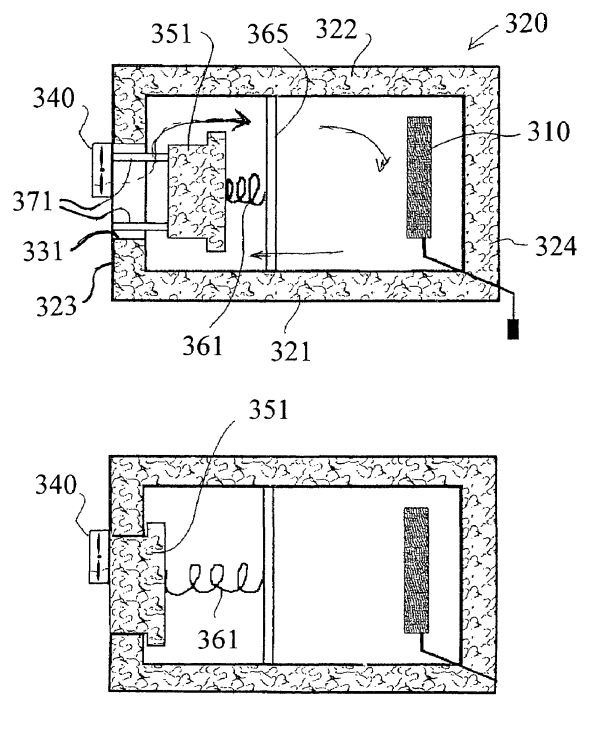
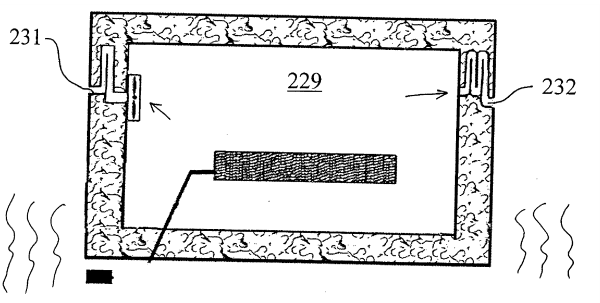
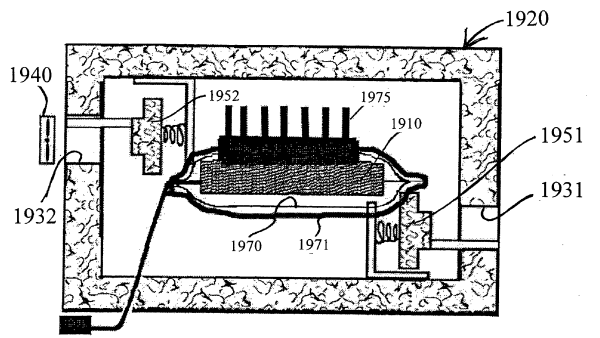
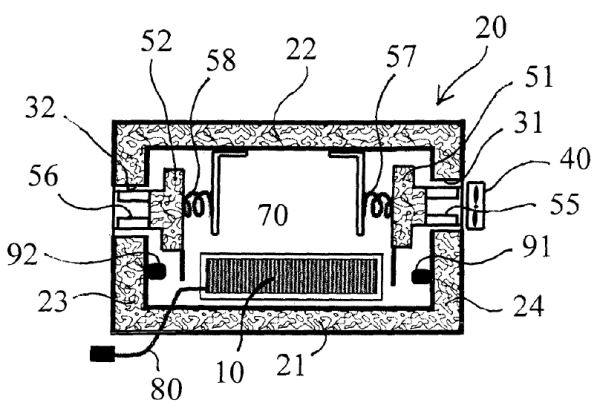
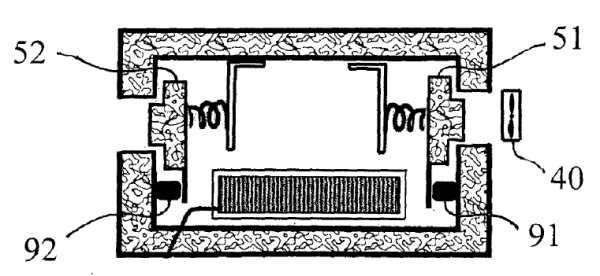








34 Comments
View All Comments
zanon - Monday, April 9, 2012 - link
First, thanks for your reply! Regardless of the situation, it's always appreciated when the author gives feedback.My biggest fundamental problem with your coverage is that I really think it does get some key points wrong and do a disservice to readers who might not know better. There are certainly valid reasons why a local solution might be useful/necessary, but storage and security aren't among them and Anandtech isn't a site that should be fuzzy with the details on matters like this, IMO.
This is silly. You have no "guarantees", per se, about anything tech related. What's your "guarantee" that a meteor won't come out of nowhere and obliterate Microsoft next week? Nothing. But that's not how data security or uptime is managed, no one ever says "100%", it's all about probability, and how many "9's" you're willing to pay for. A company like Code 42 or Amazon have been around many years now, and appear to have very stable models. Same with all the other reputable players. The odds of them just up and vanishing without warning are miniscule, and the important thing is that those odds are weighed against the risk odds of the individual, which are far more significant.
No common individual can even vaguely match the kind of backup and redundancy that a pro solution can. Good ones have replication to multiple redundant data centers (which in turn have their own replication). They have physical and environmental security. Having data "close by" is good as a secondary level to aid in rapid restores (for hardware failure and such). But a hardened case won't necessarily work for serious disasters, or against some of the most key threats of all, like theft (or confiscation). A single drive with no redundancy isn't even much use against data corruption.
Oh, I'm sure too. There are situations where a given location may simply not have access to broadband, or only via something expensive/highly asymmetric like satellite. When data is expensive enough, it also just makes sense to have multiple redundant setups in place. But if they could do an online remote solution as well (online remote doesn't mean "cloud" necessarily) but aren't because they're worried about space, security, or more likely are just ignorant that's not a shining example for you to point to, that's companies being foolish, as they so often are. We know better.
It's worth repeating and double emphasizing too that "remote replication" doesn't necessarily mean "cloud". Software like CrashPlan (or lots of others, or roll your own with open source), for free, enables backing up to any system connected to the net. So a few friends living in different areas can all agree to host backups for each other (or a business might replicate between offices).
Thanks again for your response.
robb.moore - Tuesday, April 10, 2012 - link
Hi zanon-Great comments - you seem like a really knowledgeable person. Couple of observations:
1. The Pentagon uses ioSafe. Arguably with the biggest IT budget on the planet, why choose ioSafe? They have a remote office with Macs. Pentagon runs on Windows. The remote office has vulnerable data, at risk and they're not allowed to backup over the internet due to security concerns.
2. "Serious" business with thousands of remote offices choose ioSafe to backup vulnerable data not in the data center. They utilize ioSafe as a temporary backup location until the data can be uploaded or taken offsite. ioSafe plugs a vulnerability in their DR plans. It's not perfect but it was better than having thousands of endpoints backing up to the data center between the hours of 2am and 4am.
3. Many IT people don't like the idea of perpetual incrementals. They prefer to take daily or weekly snapshots of the entire server, OS and programs and recover from "clean" images. Balancing Recovery Time Objective (RTO) with Recovery Point Objective (RPO) is tricky for all businesses to do more with less. ioSafe can often times help RPO/RTO for business with vulnerable data and limited budgets.
4. Data creation outpaces online bandwidth in growth. This is expected to remain true for decades to come. It's as if the Atlantic Ocean is growing faster than the garden hose you're pushing it through. Data created locally will generally stay local. Data created in the cloud will generally stay in the cloud. It's tough to push massive amounts of data across a pipe that proportionally getting smaller over time.
We're big fans of the private cloud - Local data that can be access remotely on any device. ioSafe is one solution of many to help mitigate the risk of loss for the local data. Every situation is a little different though.
Excellent comments.
-Robb
Robb Moore
CEO
ioSafe
DanNeely - Monday, April 9, 2012 - link
"The unit protects data from loss up to 1550°F for 1/2 hour as per ASTM E119"Without comparison to major house/apartment/office fire numbers this rating by itself is fairly meaningless. My biggest question would be what does the long tail of fire heating to do it? The main blaze could be extinguished in a house fire within the 30m timeframe; but fire fighters need to hang around for hours afterwards because hot spots will periodically flare back up.
robb.moore - Tuesday, April 10, 2012 - link
Hi Dan-The average house fire lasts 10-20 minutes at about 1100 degrees. Almost all fires involve water. In fact most of the damage is done by the fire fighter hoses than by the fire. Typically, when a room burns, all the fuel in the room is used up in a relatively short time. If a building burns for a couple hours, it's not the same spot burning as the fuel gets used up over a few minutes.
1400 degrees is a VERY hot section of the fire (typically right at the ceiling. As you move downward in the room, the temps drop into the 300-400 degs F near the floor.
-Robb
Robb Moore
CEO
ioSafe
rs2 - Monday, April 9, 2012 - link
A simple hard-drive failure is a far more likely occurrence than a fire or a flood, and for all its imposing presence and costly engineering this solution does nothing whatsoever to protect against internal failure of the mechanical disk. That shows a troubling lack of foresight.Would it have been so difficult for them to also include some sort of cloud-based data backup/replication service with this device? Obviously the people in the market for such a product are people who seriously care about the safety of their data, so it would make sense to market a solution that covers all common failure modes; fire, flood, and physical device failure.
robb.moore - Tuesday, April 10, 2012 - link
Hi rs2-As mentioned in a previous response:
That being said - the ioSafe SoloPRO is meant as a backup target - not primary storage. At ioSafe we highly recommend that our users follow a minimum of our 3-2-1 Backup Rule.
Human error (accidental deletion, format, etc.) is our #1 reason for recovery. It's amazing to me how many people confuse "backup" to mean "move" and not "copy"
It's very wrong (as I think you're trying to explain) to "move" all your data onto a single drive. It's also very wrong to move all your data onto a 100 disk RAID array without a backup.
It's just as easy to accidentally format a large RAID array as it is a single disk - the human is the weak link.
We've considered layering in some kind of cloud offering. Mozy and Carbonite both recommend onsite external drives to supplement their cloud backup. I guess I see it as we're better than 99.9% "good" already. There are lots of companies that do cloud backup and there's only one ioSafe.
thanks for the comments!
-Robb
Robb Moore
CEO
ioSafe
DonCBurr - Monday, April 16, 2012 - link
RobbI agree with your 3.2.1 strategy and I agree with your analyses of the cloud when data becomes large which is why I like this concept; but I have to disagree with the idea of a single drive rather than RAID 1
Even in my home environment data is stored in RAID 50 (fifty) and complete images are backed up to external drive RAID 1 drives; which I can put into our fire-safe that has a .rating of 45 minutes @ 1400 degrees BUT that requires backing up and swapping drives. RAID 1 because drives can and will fail and Murphy’s Law says it WILL fail when you need it the most. (and frankly most RAID implementations are not that much more than single drives implementations e.g. Sans Digital))
Now if I could only run a long cord into the safe and continuously back up the data that would be great, but not practical; which is why I looked at your product: however IF I am to rely on your solution for the Fire/Water/Earthquake event (as opposed to the long-cord solution ) then I surely want the latest online real-time backup and RAID 1 simply reduces the odds that a single drive and single point of failure will be responsible for data-loss since the odds that two drives will fail at exactly the same time is pretty low.
I hear you may have a NAS version with RAID coming out, which I am excited to see; but NAS adds a bunch of costs that a simple eSata, USB3.0, FireWire would not have.
I certainly think that a $200.00 premium over standard drives as Anandtech points out, is worth it. So if I use this as the bench mark and I can buy a SansDigital RAID 1 box w/ eSata and USB 3.0 for 130.00 and put 2 1TB drives into it for about $200 that 330 + 200 = $530.00: I am a buyer at between $495.00 and $530. (doesn’t $495 sound SO much less than $530)
My two cents….
robb.moore - Monday, April 23, 2012 - link
Thanks Don for the feedback. Disks in RAID can be a good way to help guard against single disk failure. For many though, the concept of RAID, or confusing RAID with "backup" is common.Specifically speaking to the odds, ioSafe has a track record of protecting people's data better than 99.9% when our hardware + Data Recovery Services are used together. This stat is inclusive of all our customers various techniques and scenarios for data loss (human error, fires, floods, hdd failure, etc. etc.)
Adding RAID to the backup target will incrementally improve chances of recovery but probably not as much as you think if you're already creating a redundant backup copy in the first place.
Where RAID can dramatically benefit a business is what Disaster Recovery folks call Recovery Time Objective (RTO). There's a big advantage to having a disk failure that can be corrected by hot swapping a disk resulting in zero downtime if you business requires it.
We highly recommend a RAID array for your main server if you're a business. RAID on the backup target can help incrementally improve your chances (0.005% better?) but so will 2 backup targets (twin external hard drives), online backup and offsite vaulting if this worries you.
There are all kinds of techniques to improve your chances and every situation is a little different.
Thanks again for your comments.
Robb Moore
CEO
ioSafe
EddieBoy - Tuesday, April 10, 2012 - link
I see that Costco.com has the 3 TB version for $349.99. Very tempting...bobbozzo - Tuesday, April 10, 2012 - link
Nothing is Disaster-Proof (or fireproof or hackproof or whatever)... Please use terms like disaster-resistant instead when reviewing such products.